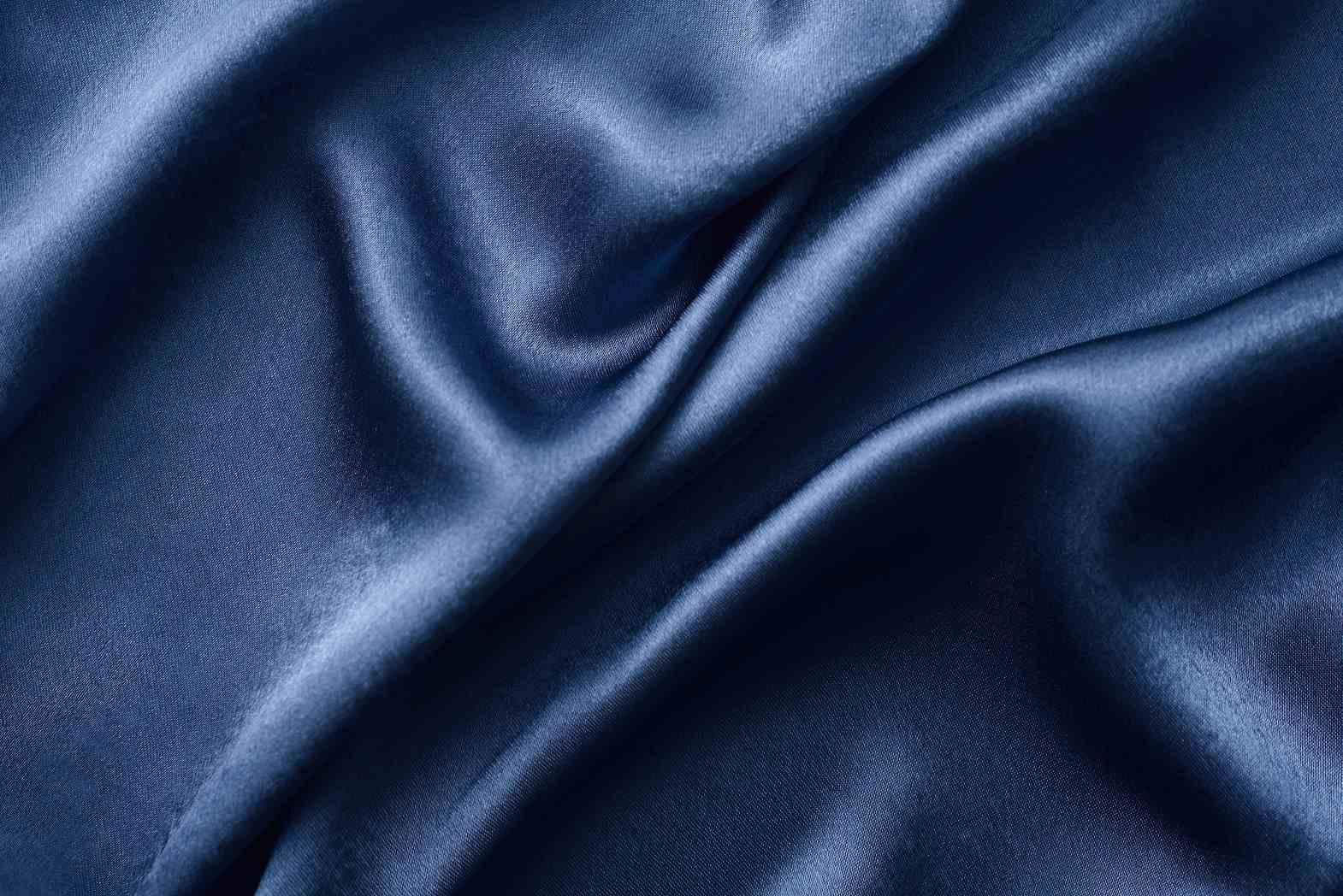— [CHR—CO—NH] n—
With n = 1100 and R being one of the 18 different types of amino acid residues as shown in figure, of the 16 amino acids, glycine, alanine, and serine are the three simple amino acids that constitute the major part of it i.e. 85%. However, about 70% of the amino acids are hydrophobic in nature and lie near the fiber surface. Therefore, even though the fiber is having a very high moisture regain i.e. 11%, it does not absorb the moisture or sweat from the skin instantaneously like cotton. Therefore, the garments made of silk are not suitable for summer wear.
Polypeptide molecule
Characteristics of silk
The silk fiber appears like solid rods with a triangular cross-section, which is responsible for the luster of the fiber. The feature of the fibroin structure, i.e. the occurrence of the three simple amino acids as the major constituent, is responsible for the characteristic mechanical properties of the silk fibers, i.e., good strength and resistance to extension attributed to the close packing and strong interchain forces between the sections of molecular chains containing simple amino acid residues. Silk is a poor conductor of heat, and a poorer conductor of electricity, but peculiarly enough; under friction, it is a fair generator of electricity and is capable of spontaneous combustion. Compared with the other natural fibers, silk has certain specific characteristics, which set it apart.
Properties of Woven Silk UnionFabrics
The deformation behavior of silk and polyester fabrics was determined. The fabrics tested were silk habutae, consisting of twist less continuous filament yarns in both the warp and the weft; silk dechine, consisting of continuous high twist filament weft yarns and twist less continuous warp yarns; silk georgette, consisting of high twist filament weft yarns in both the warp and the weft; and polyester fabrics of both the habutae and dechine types. A Kawabata Evaluation System measured tensile, bending, shearing, and compression properties. The fabric properties were combined with information about fabric thickness, crimp, and wave shape to determine the effective void volume of the fabric.
Spun silk polyester was used for developing products for home interiors as a creative endeavor to design and produce novel home interior products. A survey was conducted to gather varied respondents from the field of commercial art, textile, fashion and interior designers and homemakers. The most preferred product was the lampshade followed by the table runner. Respondents gave positive response with a high level of acceptance and the products seemed to have commercial value.
Considering the properties of eri silk and the cost of viscose rayon, a study was conducted by interweaving viscose rayon with different counts of eri silk to explore its properties so that even a common person can enjoy the unique richness of silk with excellent softness of viscose rayon. An effort has been made to emerge the richness of silk with the brilliancy of viscose rayon that offers cost effective, yet attractive fabrics in various combinations. In case of subjective evaluation most of the respondents opined that all the union fabrics were slightly stiff to handle. In general, majority of the respondents preferred union fabrics whose cost of production was lower.
Silk Blends
In an effort to discover a lower
cost alternative to silk, researchers studied the performance of silk,
polyester and nylon in filament form and in blended fabrics. Several blends and
weaves were tested. Nylon multifilament covered yarn fabric with a satin weave
gave a silk-like hand and appearance.
Silk Union fabrics
There was a study on the low stress mechanical properties of woven silk union fabrics with mulberry silk warp and mulberry silk, cotton, linen. Viscose, modal, excel (lyocell) and polyester weft yarns as weft using KES F and has also studied the cluster analysis and discriminant analysis these fabrics.
Fabric Handle and Review of Previous Work done
After the performance of clothing found to be in use has been satisfactory to some extent, consumers seek better quality, that is, more comfortable fabric. With the introduction of various types of 'Shingosen' fabrics, which are silk like fabrics made from new man-made synthetic fibres, there has been an increasing interest in the objective evaluation of the fabric handle. This is being effectively used as a quality control tool in the manufacture of the silk fabrics on a mass scale. Thus, consumers and textile exporters are likely to use hand as the first attribute of fabric quality for apparel or home furnishings.
The theoretical primary hand values of the spun bonded silk fabrics were computed from the mechanical properties determined with the KES-FB and compared to that of a comparable spun bonded polyester fabric. The differences in handle characteristic of the silk and polyester fabrics are explained in terms of inherent fibre properties, the distribution of fiber orientation and the bonding characteristics of the fabrics.
The KESF was demonstrated to be capable of bringing out the unique handle characteristics of the silk fabric, which is related to fibre property, freedom of fibre mobility, fibre distribution, fibre geometry and bonding characteristics.
The new trend in textile technology
We are now entering the second generation of textile technology. The second generation is the engineered design of textiles based on more advanced technology. The textile industry is still experience preceding industry from technical viewpoint. The precise design of engineered manufacturing of textile products is difficult even today. We are now moving towards the engineered
design of textiles focusing the design of ideal suiting. The goal is the engineered design of the ideal quality of suiting on the basis of fibre science, textile mechanics and the objective measurement technology. We are now proceeding to create a guideline for producing ideal fabrics. Ideal fabrics are those, which satisfy the following three conditions:
- Good hand (high THV)
- Good appearance of suit (high TAV)
- Mechanical comfort conditions.
References:
- Anjali A. Kulkarni (2007), Quality characteristics of viscose rayon and eri silk union fabrics, Ph.D. Thesis, Dept. of Home Science, University of Agricultural Sciences, Dharwad, India.
- Anita A. Desai, (2014) Ph.D. Thesis titled A study of the properties of woven silk union fabrics submitted to Visweswariah Technological University, Belgaum, India.
- Gohl & Velinsky (1983), Textile Science, Longman Chesire Publ., Ed 2 Reprint.
- Hearle J.W.S. and Amirbayat J. (1987), `Objective evaluation of fabric handle', Textile Month, Jan.
- Hwo S.M., Jang C.H., (1994), Woven Silk Mechanical Properties, Textile Asia.
- Kawabata S., Niwa M., (1988) Influence of fibre and process parameters on product performance, Proceedings, Fibre science / dyeing and finishing groups joint conference.
- Kawabata S. and Niwa M. (1989), `Fabric performance in clothing and clothing manufacture', J. Text. Inst., Vol.80, pp.19-50.
- Ruji Yang (1985), `Evaluation of the hand of spun bonded silk', Objective measurement applications to product design and process controlled 3rd proceedings of the 3rd Japan/Australia Symposium. The Textile Mach. Soc. of Japan.
- Sampura and Karnad., (2011) Product development from spun silk/polyester fabrics printed with geometric motifs and newsprints for home interiors, Colourage, Vol. No.3, pp. 40-48.
- Subramaniam V., Sivakumar M., Srinivasan V. and Sasikala M. (1990), `Determining factors that affect fabric shear behavior with the twist method', Textile Res. J., Vol.60, pp.368-370.
- Tadele A.B, R.S.Gandhi, (1990) Filament yarn blending of silk with polyester and nylon, Indian Text Journal,


 (1)20240730094415.jpg)






Comments